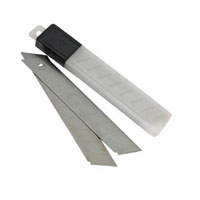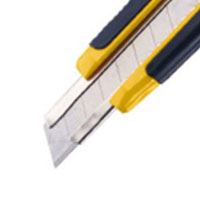 A couple of decades ago, no one knew anything about this tool. It didn’t exist yet, it wasn’t invented in general. But now ask any adult and even a child and he will say what it is. In our article, we decided to describe the distinctive features of various types of this tool, so that you can choose a high-quality and convenient one.
A couple of decades ago, no one knew anything about this tool. It didn’t exist yet, it wasn’t invented in general. But now ask any adult and even a child and he will say what it is. In our article, we decided to describe the distinctive features of various types of this tool, so that you can choose a high-quality and convenient one.
Structurally, a clerical knife consists of a body, a blade and a mechanism for fixing the blade. Also, some models have some "bells and whistles" that increase the reliability, strength and durability of the knife.
To begin with, we note that all stationery knives vary in size depending on the width of the blade. 3 blade sizes on sale : 7 mm, 9 mm and 18 mm. The blades of these knives have a distinctive feature. Along the entire length of the blade at regular intervals there are grooves at an angle to the axis of the blade. This was done to quickly "sharpen" the blade. When the blade becomes dull during operation, with the help of pliers, the dull piece breaks off along the groove and the knife becomes as sharp as new again. In this way, you can sharpen the knife 4-5 times. After that, the blade becomes too short and must be replaced with a new one.
The blades of these knives have a distinctive feature. Along the entire length of the blade at regular intervals there are grooves at an angle to the axis of the blade. This was done to quickly "sharpen" the blade. When the blade becomes dull during operation, with the help of pliers, the dull piece breaks off along the groove and the knife becomes as sharp as new again. In this way, you can sharpen the knife 4-5 times. After that, the blade becomes too short and must be replaced with a new one.
A utility knife with a 7 mm wide blade is used exclusively for cutting paper. It is difficult to cut a denser or thicker material with it, primarily due to the fact that the blade is quite thin and bends when cut and the cut turns out to be crooked. A knife with a 9 mm blade is the most common. With it, you can cut paper, cardboard, thin leather, plastic and much more, up to linoleum.
By the way, this knife is very widely used in construction. It can simply be used for both domestic and construction purposes - as they say, "one strike with two birds with one stone." Well, the largest clerical knife with a blade 18 mm wide is already an exclusively construction knife and has nothing to do with clerical matters. 
The next element that differs in different models is the latch . On small knives, it is completely made of plastic and looks like a sliding element. When it is moved apart, the blade is fixed; when it is moved, the blade can be moved along the body. However, in good knives, the latch is made in the form of a twist with a pressure plate. This type of retainer is more reliable, since the screw is made of steel and is more durable than a plastic element. If you buy a tool not for once, but for many years, choose a screw retainer.
On small knives, it is completely made of plastic and looks like a sliding element. When it is moved apart, the blade is fixed; when it is moved, the blade can be moved along the body. However, in good knives, the latch is made in the form of a twist with a pressure plate. This type of retainer is more reliable, since the screw is made of steel and is more durable than a plastic element. If you buy a tool not for once, but for many years, choose a screw retainer.
And finally, another element that you should pay attention to when choosing a clerical knife is the tip of the body from the side of the blade. In cheap models, the case is completely made of plastic, and in expensive and good ones, a metal element is built into the tip of the case, inside which the blade moves.
This element creates additional rigidity to the blade when cutting hard materials, which does not allow the blade to bend when significant forces are applied. For those types of stationery knives that are used in construction, this is very important, since they do not cut thin paper, but durable plastic, linoleum and similar materials.
We will not dwell on the features of the hull shape. Let everyone choose here. But remember that very comfortable ergonomic cases of stationery knives significantly increase the cost - several times. If you are ready to spend a lot of money for such convenience, please, and if you just need a reliable tool, just take a model with a reasonable price, but taking into account the nuances described above.
|
Useful articles |
|
Choosing a cutting disc for metal grinder |